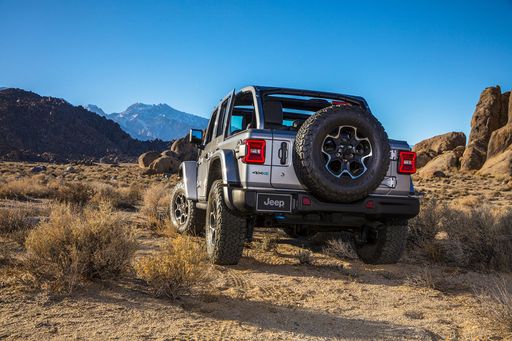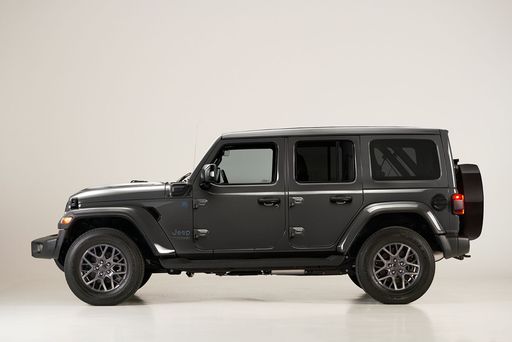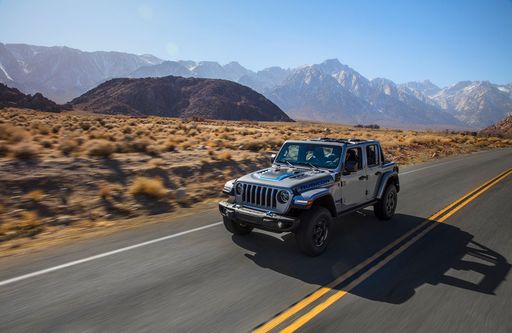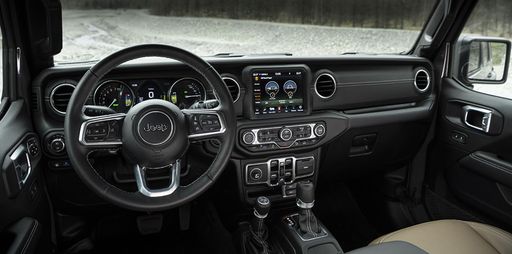Jeep Wrangler vs Mercedes Citan – Differences & prices compared
Compare performance, boot space, consumption and price in one view.
Find out now: which car is the better choice for you – Jeep Wrangler or Mercedes Citan?
The Jeep Wrangler (Off-Roader) comes with a Plugin Hybrid engine and Automatic transmission. In comparison, the Mercedes Citan (High Roof Estate) features a Petrol, Diesel or Electric engine with Manuel or Automatic transmission.
When it comes to boot capacity, the Jeep Wrangler offers 533 L, while the Mercedes Citan provides 551 L – depending on how much space you need. If you’re looking for more power, decide whether the 380 HP of the Jeep Wrangler or the 131 HP of the Mercedes Citan suits your needs better.
In terms of consumption, the values are 3.30 L per 100 km for the Jeep Wrangler, and 19.30 kWh5.30 L for the Mercedes Citan.
Price-wise, the Jeep Wrangler starts at 69900 £, while the Mercedes Citan is available from 21900 £. Compare all the details and find out which model fits your lifestyle best!
Jeep Wrangler
The Jeep Wrangler is a symbol of rugged adventure and off-road capability, renowned for its distinctive boxy design and iconic seven-slot grille. Its interior blends practicality with modern technology, providing a comfortable environment whether you're navigating city streets or challenging terrains. With a loyal fan base, the Wrangler continues to capture the spirit of freedom and exploration, making it a favourite among outdoor enthusiasts.
details @ media.stellantis.com
@ media.stellantis.com
 @ media.stellantis.com
@ media.stellantis.com
 @ media.stellantis.com
@ media.stellantis.com
 @ media.stellantis.com
@ media.stellantis.com
 @ media.stellantis.com
@ media.stellantis.com
Mercedes Citan
The Mercedes-Benz Citan High Roof Van is a versatile option in the compact van segment, offering a perfect blend of practicality and style. Its sleek design combined with the brand's hallmark attention to detail ensures that it stands out on city streets and motorways alike. Inside, the spacious cabin provides ample room for passengers or cargo, making it an ideal choice for both urban professionals and families seeking flexibility.
details

|
|
|
|
|
Costs and Consumption |
|
|---|---|
|
Price
69900 - 71600 £
|
Price
21900 - 32400 £
|
|
Consumption L/100km
3.3 - 4 L
|
Consumption L/100km
5.3 - 7.1 L
|
|
Consumption kWh/100km
-
|
Consumption kWh/100km
19.3 - 20.7 kWh
|
|
Electric Range
38 - 42 km
|
Electric Range
265 - 280 km
|
|
Battery Capacity
-
|
Battery Capacity
45 kWh
|
|
co2
74 - 91 g/km
|
co2
0 - 160 g/km
|
|
Fuel tank capacity
65 L
|
Fuel tank capacity
54 L
|
Dimensions and Body |
|
|---|---|
|
Body Type
Off-Roader
|
Body Type
High Roof Estate
|
|
Seats
5
|
Seats
5
|
|
Doors
5
|
Doors
5
|
|
Curb weight
2276 - 2383 kg
|
Curb weight
1556 - 2010 kg
|
|
Trunk capacity
533 L
|
Trunk capacity
0 - 551 L
|
|
Length
4882 mm
|
Length
4498 - 4922 mm
|
|
Width
1894 mm
|
Width
1859 mm
|
|
Height
1838 - 1848 mm
|
Height
1811 - 1830 mm
|
|
Payload
520 - 536 kg
|
Payload
485 - 644 kg
|
Engine and Performance |
|
|---|---|
|
Engine Type
Plugin Hybrid
|
Engine Type
Petrol, Diesel, Electric
|
|
Transmission
Automatic
|
Transmission
Manuel, Automatic
|
|
Transmission Detail
Automatic Gearbox
|
Transmission Detail
Manual Gearbox, Dual-Clutch Automatic
|
|
Drive Type
All-Wheel Drive
|
Drive Type
Front-Wheel Drive
|
|
Power HP
380 HP
|
Power HP
95 - 131 HP
|
|
Acceleration 0-100km/h
6.50 s
|
Acceleration 0-100km/h
13 - 15.5 s
|
|
Max Speed
156 - 177 km/h
|
Max Speed
132 - 183 km/h
|
|
Torque
637 Nm
|
Torque
200 - 270 Nm
|
|
Number of Cylinders
4
|
Number of Cylinders
4
|
|
Power kW
280 kW
|
Power kW
70 - 96 kW
|
|
Engine capacity
1995 cm3
|
Engine capacity
1332 - 1461 cm3
|
General |
|
|---|---|
|
Model Year
2024
|
Model Year
2021 - 2024
|
|
CO2 Efficiency Class
B
|
CO2 Efficiency Class
F, E, A
|
|
Brand
Jeep
|
Brand
Mercedes-Benz
|
Jeep Wrangler
Introduction to the Iconic Jeep Wrangler
The Jeep Wrangler has long been synonymous with off-road capability and rugged design. With its roots deeply embedded in adventure and exploration, the Wrangler combines classic styling with modern innovations. In its latest iterations, it continues to enhance its reputation as a robust, yet stylish, off-roader suitable for a variety of terrains and conditions.
Technical Specifications and Performance
The 2023 Jeep Wrangler models offer a range of options, with engines that are designed to deliver powerful performance and efficiency. The available engine configurations include advanced Plug-in Hybrid options, as well as traditional petrol engines. All options are paired with an automatic transmission and benefit from the capability of an all-wheel-drive system.
Power output varies from 272 to 380 PS, catering to different driving preferences and demands. The Plug-in Hybrid variant impresses with a consumption as low as 3.3 L/100km, offering an electric range of up to 48 km—ideal for urban commutes and reducing environmental impact. For those wanting a more traditional power experience, the petrol engines deliver robust performance with an acceleration of 0-100 km/h in just 6.5 to 7.6 seconds, depending on the variant.
Innovative Features and Sustainability
The Jeep Wrangler is not just about raw power; it also embodies sustainability with its hybrid technologies. The Plug-in Hybrid models are designed to offer a blend of efficiency and environmentally friendly driving experience. By integrating electric motor capabilities with traditional fuel engines, these models ensure lower emissions and enhanced fuel economy.
Beyond mechanical advancements, the modern Wrangler incorporates cutting-edge technology in its interior. With a suite of safety features and a sophisticated infotainment system, it ensures both driver and passengers enjoy a comfortable and secure journey.
Exterior Design and Interior Comfort
The exterior of the Jeep Wrangler remains a testament to its enduring legacy, featuring the iconic seven-slot grille and round headlights. Yet, it manages to blend this classic look with modern aesthetics, providing a more refined appearance that does not compromise its rugged appeal.
Inside, the Wrangler offers a spacious interior with seating for five, ensuring comfort during long drives. Thoughtfully designed with high-quality materials, the cabin provides both functionality and style. With a generous boot space of 533 litres, it caters to both city drivers and adventure seekers alike.
Versatility and All-Terrain Capability
True to its heritage, the Jeep Wrangler excels in off-road conditions. Thanks to its high ground clearance, robust suspension system, and advanced all-terrain technology, it is perfectly equipped to handle challenging terrains with ease. Whether it's muddy trails or rocky paths, the Wrangler stands ready to tackle any obstacle.
Conclusion: A Vehicle for All Adventures
The 2023 Jeep Wrangler continues to embody the spirit of adventure that has defined the brand for decades. With a combination of powerful performance, advanced hybrid technology, and timeless design, it remains a top choice for those who seek a vehicle as versatile and robust as their lifestyle. Whether navigating urban streets or exploring off-beaten paths, the Wrangler proves once again why it is an enduring favourite among off-road enthusiasts.
Mercedes Citan
Introducing the Mercedes-Benz Citan High Roof Van
The Mercedes-Benz Citan High Roof Van is the epitome of versatility and style among small commercial vehicles. Designed for modern urban mobility, it seamlessly blends practicality with innovation, making it an essential choice for those looking for capacity without compromising on quality.
Engine Variants and Performance
Mercedes-Benz offers a range of engine choices for the Citan High Roof Van, catering to varying needs. The powertrain options include efficient petrol, robust diesel, and cutting-edge electric versions, all integrated with front-wheel drive systems. With power outputs between 95 and 131 PS, these engines cater to both urban driving and long-haul needs.
For those focused on sustainability, the eCitan model provides a compelling electric alternative. The electric motor produces 122 PS and offers smooth acceleration with a range of up to 280 km on a single charge.
Advanced Technical Features
Within the Citan, technology plays a pivotal role in enhancing the driving experience. The cockpit is equipped with modern infotainment systems that support connectivity, bolstered by practical ergonomics to increase driver comfort. Additionally, the vehicle's suite of safety features, including advanced driver-assistance systems, exemplifies Mercedes-Benz's commitment to safety innovation.
Efficiency and Environmental Considerations
The Citan combines performance with eco-friendliness, offering fuel consumption figures from 5.3 to 7.1 L/100km for petrol and diesel variants. On the electric front, energy consumption is efficiently managed between 19.3 and 20.7 kWh/100 km, significantly reducing the carbon footprint compared to conventional engines.
Furthermore, with multiple engines boasting CO2 efficiency classes ranging from A to F, the Citan is designed to meet stringent environmental standards without sacrificing power or functionality.
Interior Space and Practicality
One of the most striking elements of the Citan High Roof Van is its sizeable interior, harmoniously designed to maximize passenger comfort and cargo space. With a luggage capacity of up to 551 litres, it is well-equipped for business applications and family adventures alike. The smart layout and five-seat configuration ensure the van is versatile enough to handle any task.
The Perfect Balance Between Functionality and Luxury
Mercedes-Benz has skilfully combined practicality with luxury in the Citan, offering trim levels from Base to Pro Automatik. These options provide varying degrees of sophistication and equipment, ensuring that the needs of each customer are effectively met, all backed by the brand’s renowned commitment to excellence.
Conclusion
The Mercedes-Benz Citan High Roof Van is a testament to how commercial vehicles have evolved, deftly merging utility with sophistication. Whether you are an urban delivery driver or a family seeking versatility, the Citan offers a compelling mix of practicality, efficiency, and luxury. Discover the model that suits your lifestyle and drive into a future crafted with confidence and reliability.
The prices and data displayed are estimates based on German list prices and may vary by country. This information is not legally binding.
